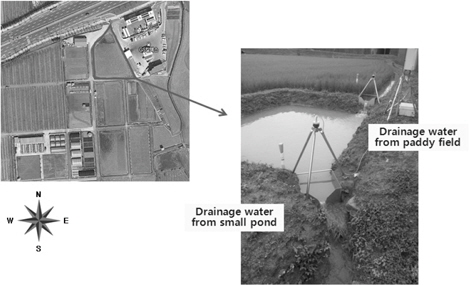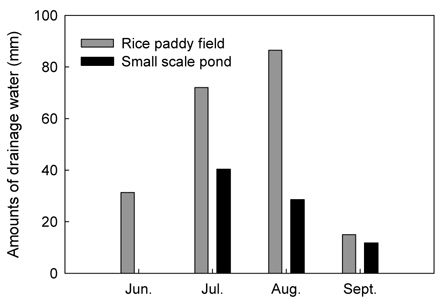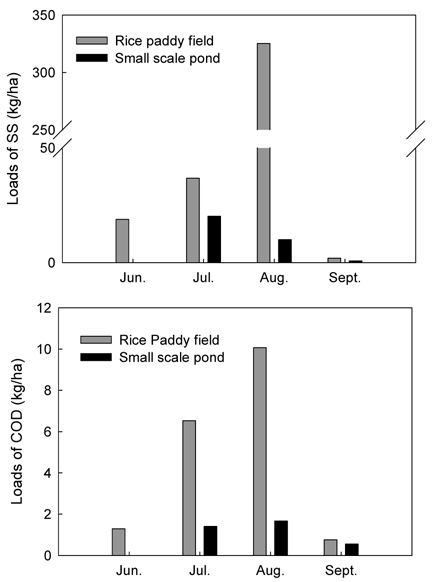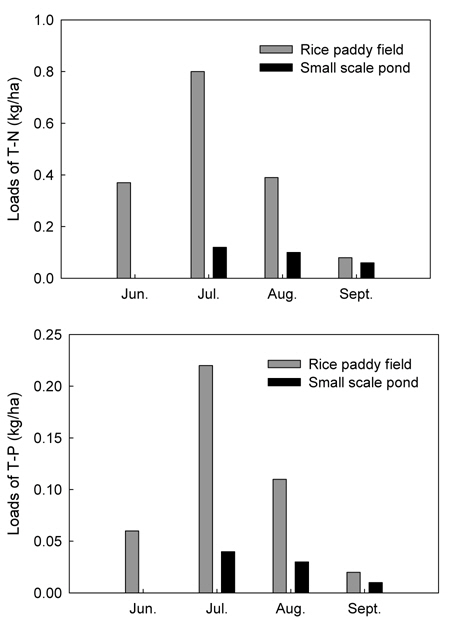



Water-born pollution loads by agricultural non-point source (NPS) pollution are expected to become intensified due to ongoing precipitation change. Therefore, it is essential to develop a best management practice (BMP) that is suitable to agricultural environments in Korea. This study aimed to develop an environmental-friendly BMP to reduce NPS pollution load by agricultural activities. An eco-friendly way, small drainage pond, was suggested in this study to avoid direct drainage of agricultural runoffs and eventually reduce the amount of pollutants discharged into the surrounding aqua-environment.
A small pond (12 m2) was constructed at the corner of a rice paddy field (1,715 m2) located in Suwon, Korea. Water was allowed to drain only via a small drainage pond. Sampling was repeatedly made at two locations, one from an entrance and the other from an exit of a pond, during the rice cultivation period (May to October, 2012). Generally, sampling was made only when runoff water drained through a pond, such as during and/or after rain (irrigation). The water quality analysis showed that all quality parameters (SS, CODMn, T-N, and T-P) were improved as water passed through the pond. The amount of runoff water was reduced by 96∼100%. Suspended solids and COD concentrations was reduced by 79.3% and 45.6%, respectively. In case of T-N and T-P concentrations, the reduction rates were 52.2% and 60.5%, respectively and the amount of T-N and T-P were reduced by 16.3∼73.0% and 15.4∼70.1%, respectively.
Our data implies that agricultural NPS pollution from rice paddy fields can be effectively managed when an appropriate drainage water management practice is imposed. In this paper, it was suggested that an installation of a small drainage pond can be effective to prevent not only the nutrient loss from rice fields but also pollutant discharge to surrounding water environments.
최근 들어서는 기후변화에 따른 강우특성 변화로 비점오염물질의 유출이 증대될 것으로 예측되어 이에 대한 집중관리가 필요하다. 특히 농업지역은 영농활동을 위해 농경지에 시용되는 가축분뇨 퇴⋅액비, 비료 등이 비점오염원으로 작용하여 이로 인한 비점오염 부하 기여율이 높은 편이다. 다른 영농형태와 달리 논은 재배작물과 투입자재가 단일 및 표준화되어 있어 비점오염원 관리가 비교적 용이하나 우리나라 전체 농경지 면적의 60% 이상을 차지하고 있고 관개와 낙수라는 특수한 물관리가 이루어지기 때문에 배출 변화의 폭이 크다(Takeda
비점오염원 저감방법은 인공습지, 식생여과대, 저류지, 그리고 물리적 여과장치(여과조, 침투조, 유공포장) 등이 이용되고 제거효과에 대한 과학적인 검증을 위한 연구는 매우 다양하게 이루어져 왔다(Kim
따라서 본 연구는 현장 적용이 용이한 비구조적인 비점오염 저감방법인 저류지를 이용하여 논으로부터 배출되는 배수를 관리하고자 국립농업과학원 기후변화생태과 시험포장에 특별한 장치나 저감시설이 필요하지 않는 저류지를 설치하고 2012년 5월부터 9월 영농기간 동안 그 효과를 분석하였다.
본 연구를 위해 2012년 영농기 전인 4월에 경기도 수원시 권선구 서둔동 국립농업과학원 기후변화생태과 시험 포장인 논(1,715 m2; 37°16′28.72″N, 126°59′10.53″E)의 말단부에 논 배출수가 외부 수계로 배출되기 전 저류지(12 m2; 4×3×0.7 m)를 조성하였다. 조사지역의 영농활동은 5월 초순에 경운후 기비를 투입하고 이앙을 하였으며 5월 하순에 분얼비와 8월 중순에 이삭비를 각각 투입하였는데 재배기간 동안 질소와 인 시비량은 각각 90 kg/ha과 30 kg/ha 이었다. 조사지역의 토양은 미농무성의 삼각좌표 분류법에 의해 미사질 양토(Silt loam)이었다. 시험 전 논토양의 유기물 함량은 12 g/kg이었고, 유효인산 함량은 69.2 mg/kg으로 우리나라 논토양의 평균함량(RDA, 2011)보다 낮았다.
시험포장에 수문관측 시설을 설치하였는데 먼저 조사지역의 강수량을 측정하기 위해 시험포장 인근에 강우량계(260-2501 Novalynx Co., USA)를 설치하여 현장에서 직접 강수량 자료를 수집하였다. 또한 시험포장인 논과 저류지의 유출량을 조사하기 위해 유출구에 위어(Weir)를 설치하고 초음파 수위 센서(280-IRU-94 Novalynx Co., USA)를 설치하여 10분 간격으로 유출수의 수위를 관측하였다(Fig. 1).
토양시료는 시험 전 채취하여 분석하였는데 토양의 pH와 EC는 각각 pH meter(Model 720A, Orion)와 EC meter(Model 145A, Orion)를 사용하여 측정하였다(NIAST, 2000). 토양 중 유기물은 튜린(Turin)법, 유효인산은 랑카스터(Lancaster)법, 치환성 양이온은 1N 초산암모늄(NH4OAc) 용액(pH 7)으로 침출하여 유도결합플라즈마분광기(ICP-OES, GBC Integra XMP, Australia)를 이용하여 분석하였다(NIAST, 2000).
물시료는 강우로 인해 논과 저류지의 유출이 각각 발생한 경우 유출지점에서 시료를 채취하였다. 수질분석은 표준분석법(APHA, 1998)과 수질오염공정시험기준(MOE, 2008)에 의해 COD는 과망간산칼륨법, T-N은 자외선흡광광도법, T-P는 아스코르빈산환원법 그리고 부유물질(SS, Suspended solids)는 유리섬유여지법에 준하여 분석하였다.
본 연구의 조사기간인 2012년 5월부터 10월까지 강우량은1,455 mm로 전체 강우량(1,748 mm)의 83.4%를 차지하여 영농기에 집중되는 전형적인 우리나라 강우패턴이었다. 또한 예년에 비해 6월의 강우량은 적은 반면에 7월의 강우량이 많았으며 일 강우량이 276.5 mm인 강우사상도 있었다. 특히 강우량이 많고 요수량이 커 담수심이 높은 7월과 8월에 논 배출수량도 많았다. 이는 강우량과 지표 배출수량은 고도의 정의 상관이 있다는 연구결과(Kim
조사기간 동안 저류지 유입 전인 논 배출수와 저류지 배출수량은 영농초기인 5월과 6월에는 벼의 요수량이 많으면서 강우량이 적어 논에서의 지표 배출은 없었고 9월 중순부터 물떼기를 하여 10월에도 논에서의 지표 배출이 없었다(Fig. 2). 그러나 7월의 논과 저류지의 배출수량은 각각 72.0과 40.4 mm이었고, 8월에는 각각 86.5와 28.5 mm, 그리고 9월에는 각각 15.0과 11.8 mm 이었다. 따라서 영농기간 동안 논 저류지를 이용한 논 배출수량의 저감 효과는 21.7∼100%로 강우량이나 논의 물관리 형태에 따라 상이하였다.
조사기간 동안 저류지의 유입 부하량인 논과 저류지의 SS와 CODMn 배출 부하량을 비교한 결과(Fig. 3) SS의 경우 유입 부하량이 평균 95.7 kg/ha 였는데, 유출 부하량은 평균 7.7 kg/ha로 낮아져 76.4의 높은 정화효율을 보였다. 이는 저류지를 통과하면서 체류시간을 증가시켜 유속을 느리게 하여 부유성 오염물질을 침강시키는 저류지의 기능(Mitsch and Gosselinl, 2000)이 있는 것으로 생각된다. CODMn의 경우도 유입 부하량이 평균 4.66 kg/ha이었고 유출 부하량이 평균 0.91 kg/ha로 낮아져 72.4%의 높은 정화효율을 보였다. 이와 같이 농도가 높은 논 배출수가 저류지를 통과하면 유기물도 많이 정화되는 것으로 생각된다.
조사기간 동안 저류지의 유입 부하량인 논과 저류지의 T-N과 T-P 배출 부하량을 비교한 결과(Fig. 4) T-N의 경우 저류지 유입과 배출 부하량이 각각 0.08∼0.80과 0.00∼0.12 kg/ha로 영농기간 동안 71.1%의 높은 정화효율을 보였다. T-P의 경우에도 저류지 유입과 배출 부하량이 각각 0.02∼0.22와 0.00∼0.04 kg/ha로 영농기간 동안 76.1%의 높은 정화효율을 보였다.
습지나 저류지에서 식물과 조류를 포함한 미생물에 의해 흡수되어 제거되는 질소는 1∼34%를 차지하는 반면에 탈질화에 의해 제거되는 질소는 60∼95%를 차지하는 것으로 보고(Cooke, 1994; Spieles and Mitsch, 2000)되고 있으나 본 연구에서는 저류지 조성 초기이므로 저류지 내 토사가 침전되어 제거된 것으로 생각된다. 따라서 추후 장기 연구를 수행하게 되면 저류지내 식물과 미생물에 의한 흡수와 탈질화에 의해 제거되는 질소에 대해서도 고려해야 할 것으로 생각된다. 또한 인의 제거 기작은 흡착, 침강, 조류 및 습지식물의 흡수 등 여러 물리적, 화학적, 생물학적 과정에 의해 이루어지는데(Kim
이와 같이 논의 배출 농도가 높아지고 배출량도 많은 강우시 논의 배출수가 저류지를 통하면 비점오염물질을 정화할 수 있어 외부 수계의 수질에도 긍정적인 영향을 미칠 것으로 생각된다. 따라서 경지기반 정리되어 용수의 취⋅배수가 용이한 논에서는 외부 수계로 배출되기 전 저류지를 설치하면 영양염류의 배출이 저감될 것으로 생각되며 특히 농업보호구역 및 농업진흥지역에는 논 배수 저류시설 등의 자연 정화형 비점오염 저감방안을 마련하도록 정책부서의 제도 개선이 필요하다고 생각된다.



